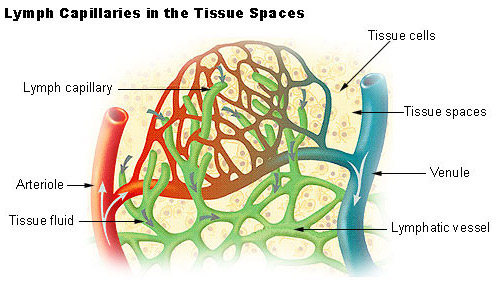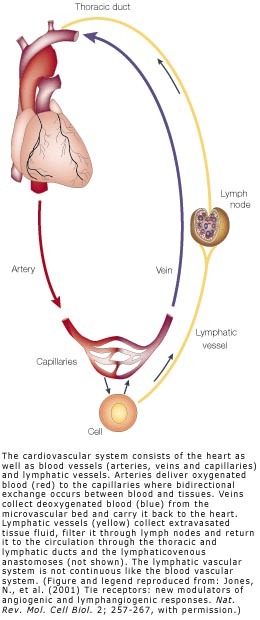Describe How the Lymph Returns to the Blood
Any changes in these systems can be very harmful for the health of the person. The other trunk is.

The Lymph 9 5 1 Cie Igcse Biology Revision Notes 2020 Save My Exams
And the function of lacteals is to help in the absorption of digested food materials generally fats from the intestine.

. Lymph caries digested and absorbed fat from intestine and drains excess fluid from extra cellular space back into blood. It joins with the subclavian vein and thus returns lymph to the bloodstream. 2 points 1 It drains into a larger lymph node which returns it to the subclavian veins.
How does lymph return to the circulatory system. The lymphatic system a complex network of vessels is essentially a drainage system within the body which transports excess fluid and metabolic waste products from interstitial spaces into the blood circulatory system. Out of these two trunks the right duct drains the upper right portion which returns the lymph to the bloodstream.
Passage of lymph is supported by muscular contractions and valves. 90 of this fluid returns to the venous circulation through the venules and continues as venous blood. Describe how lymph is formed from blood until it is brought back into the blood circulatory system.
If these systems do not work efficiently then the immune response of the body would be less efficient and would increase the risk of infections. Lymph fluid enters the lymph nodes removing foreign bacterial bodies from the bloodstream. Once within the lymphatic system the extracellular fluid which is now called lymph drains into larger vessels called the lymphatics.
One of these trunks the right lymphatic duct drains the upper right portion of the body returning lymph to the. The remaining 10 of this fluid becomes lymph which is. Lymphatic vessels drain fluid called lymph from tissues throughout the body and return the fluid to the venous system through two collecting ducts.
The thoracic duct and right lymphatic duct drain into the subclavian veins to return lymph to the blood. After these substances have been filtered out the lymph leaves the lymph nodes and returns to the veins where it re-enters the bloodstream. The remaining fluid called lymph contains lymphocytes which are a type of white blood cell that is important to the immune system.
Now if you are asking how the majority of LYMPH fluid re-enters the blood stream the answer is through the R lymphatic and L lymphatic aka thoracic ducts at the location of the R subclavian or R internal jugular and L subclavian veins respectively. Transport excess fluid away from the interstitial spaces in most tissues and return it to the blood stream Trace the general pathway of lymph from the interstitial spaces to the blood stream Lymphatic capillaries--lymphatic vessels--lymph nodes--larger lymphatic vessels-- lymphatic trunks--lymphatic collecting ducts--subclavian veins in thorax. The Thoracic duct other lymphatic trunk drains the rest of the body into the left Subclavian vein.
Tagged with biology lymph circulatorysystem. Anatomy and Physiology with Integrated Study Guide 6th Edition Edit edition Solutions for Chapter 13 Problem 2LO. Thus lymph is returned to the blood stream.
Describe the structure of the lymphatic system including the composition of lymph the vessels that carry it its pathway to return to the heart. Describe the pathway of lymph in its return to the blood. Lymph is basically blood plasma without the blood cells the fluid that is.
3 It drains into a larger lymph trunk which returns it to the subclavian arteries. The thoracic duct is the largest lymphatic vessel. Which blood vessel is the lymph returned to.
2 It drains into a larger lymph trunk which returns it to the subclavian veins. Lymph returns to the circulatory system by entering large veins near the heart. The lymphatic system drains fluid that has been released from the bloodstream filters it and returns it back to circulation.
Get solutions Get solutions Get solutions done loading Looking for the textbook. The lymphatic vessels are where the lymph drains and these vessels form one of the two large vessel called lymphatic trunks. The lymphatic vessels are punctuated at intervals by small lymph nodes that remove foreign materials and infectious micro organisms.
Lymph flow is governed by extrinsic forces due to the movements of organs and skeletal muscles which exert external pressure on the lymphatic walls and by the. The fluids in the blood leak through the capillaries and into the surrounding tissue. One of the principal functions of the lymphatic system is to gather this fluid and return it to the blood system to maintain overall fluid balance.
How does lymph return to the circulatory system from the lymphatic system. These vessels converge to form one of two large vessels called lymphatic trunks which are connected to veins at the base of the neck. Lymph nodes pull out the waste and then the filtered fluids travel to the lymphatic ducts and are redistributed into the blood.
After plasma has delivered its nutrients and removed debris it leaves the cells. The hematological and lymphatic systems are two systems that protect the body from infections and other harmful substances. Fluid in the interstitial spaces is often at subatmospheric pressure and the return points into the venous system are at pressures of approximately 20 cmH 2 O.
Most of the lymphatic vessels have valves like those in veins to keep the lymph which can clot flowing in the one direction toward the heart. The function of lymphatics is to carry tissue fluid from tissues to veins and the return of water and protein from the interstitial fluid to blood from which they come.

Seer Training Components Of The Lymphatic System


Comments
Post a Comment